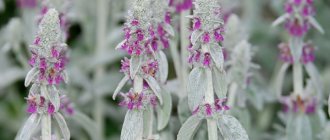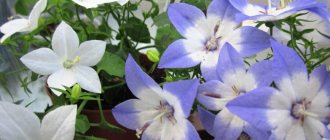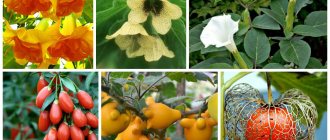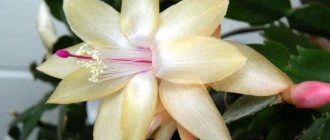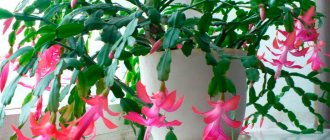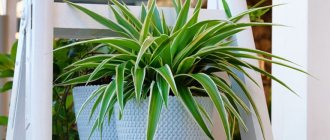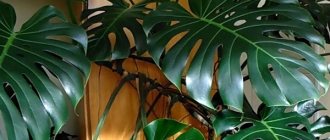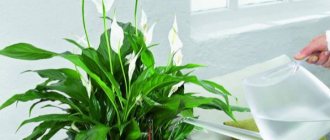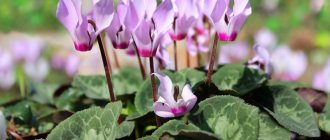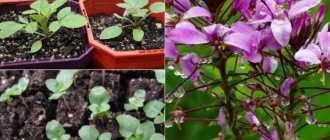Chistets Woolly is a perennial plant, a representative of the Lamiaceae family, which has a fairly powerful, developed root system. Its growth reaches approximately 20–25 centimeters, not counting the size of the peduncles, which can exceed a height of 50 centimeters. Flowering period is from May to mid-September.
Mature plants form continuous fluffy living carpets. To maintain this effect, many gardeners cut off flower stalks. In order for the leaves to have a rich green-silver color and pronounced pubescence, they need a lot of sunlight - this should be taken into account when choosing a place to grow “bunny ears”.
Hemanthus in nature
The hare's ear flower is a heat-loving plant. In the wild, it grows in tropical Africa in the Cape Province. Here on the mountain slopes in the shade of spreading bushes this plant feels simply excellent. The name “hemanthus” was coined for it by Carl Linnaeus in 1753. It is translated as “bloody.” Indeed, plants with bright red flowers are mostly common in nature. However, over the centuries, other varieties have been developed that have flowers of a different shade. These include Hemanthus white-flowered. It is also quite a showy plant. Its inflorescence is large in size and looks fluffy due to the large number of stamens. Hence another name for hemanthus – “hare’s tail”.
Chistets Byzantine (stachys woolly) - donkey ears
Added: Dec 26, 2019
It turns out that in life some people, pictures of things seen or names are remembered. Not all, but some. For several years I have retained the name of one plant in my memory, namely, “donkey ears, sheep ears, hare ears.” I remember looking on the Internet for the name of a Ledeburia I saw on a tropical island. I looked through all the plants similar to it. And I saw a strange plant. It looks like it's made of felt. But it was in the pictures. I didn’t know if it was really like that in appearance. And finally, I saw this plant in a southern city. As soon as I saw the lawn raised high above the surface on which exactly these plants grew, I immediately remembered those pictures and this unusual name. It was right on point though. The leaves of the plant are very similar to donkey ears.
I really liked this well-groomed ridge with Chistets Byzantina or Stachys woolly. This is exactly what this plant is called. Chistets belongs to the Lamiaceae family, genus Chistets. The Chistets genus includes more than 300 plant species. They are growing all over the world. But only Byzantine chist is grown as an ornamental plant. It is a herbaceous, perennial plant with silvery leaves. I began to encounter small islands with Byzantine chistets. But it was not an attractive sight. Only well-groomed chistets plants look attractive. In the fall, I saw Chistets Byzantine plants for sale in a garden center catalog. But I had no desire to buy it and grow it in a container on a closed loggia. Precisely because not all plants look beautiful if the growing conditions are not suitable for them. But the pure plant is still a garden plant. And it is unlikely that it will be favorable for it to grow in a container and on a closed loggia. Now you can forget such a funny name for the plant “donkey, sheep, hare ears.” I saw this plant and now I know why it is called that.
I have known this plant well and for a long time - I became acquainted with it under the name “sheep’s ears”, and then, like you, I learned that it is correctly called “chistets”. The plant is attractive in appearance and “touchable” (that’s what my daughter says) - she comes up to it and strokes the leaves. Chistets are great for edging flower beds and for shading bright colors. I have only one problem with it - it doesn’t winter well: if you don’t cover it, it will freeze; if you cover it, it will freeze out.
general description
The leaves of hemanthus have a rich dark green hue. The plates themselves are quite wide and thick. They grow vertically upward in pairs, and their tips hang down on both sides, which gives them the appearance of bunny ears. Usually up to 4-6 leaves grow in one pot. In an adult hemanthus, their length can reach 30 cm. The height of the peduncle is 20-60 cm.
The hare's ear flower is a bulbous plant, and therefore does not like stagnant water. It needs good drainage in the pot. The bulb of this indoor flower is very large - up to 12 cm.
In winter, hemanthus begins a period of rest. This plant reproduces by seeds, daughter bulbs and leaves. Its main features also include the very slow growth of leaves. Also, apartment owners who want to purchase this plant should be aware that it can cause allergic reactions.
Kinds
Monilaria moniliformis
A small shrub consisting of granule-like shoots. There are two types of leaves - small, almost fused and long, which break the primary leaves at the beginning of the wet period. Blooms with white or yellow flowers. The flowers have a weak aroma. They grow on separate peduncles. When the leaves dry, they form a parchment-like skin that protects the plants from dehydration.
Monilaria monilareformes
Monilaria obconica Maerpoort
The succulent, which forms a tussock with a diameter of 30 cm, has short stems with a bead-like structure. The leaves are bright green, with a characteristic pearl tint. This species most closely resembles lithops - “Living Stones”. It blooms with small white or pink flowers. During the dormant period, only stumps are visible, looking like dried roots.
Also read: Bottle tree (Nolina): a tropical plant in your home
Monilaria obconical
Monilaria scutata
A hummock-shaped succulent with thick roots that connect to each other like a necklace. The leaves are paired of two types: the first is rounded, the second is more ordinary, elongated. The second pair of leaves diverges in a V-shape. Young leaves have a reddish tint, mature leaves are green, the skin is lumpy, characteristic of all Monilaria. It blooms with single, medium-sized 2.5-3.5 cm in diameter with 5 unequal, tuberculate sepals. The color is varied: from white with a yellow border to purple.
Monilaria scutea
Monilaria pisiformis
It is distinguished by taller knotty stems. Otherwise it has all the usual signs of Monilaria. Blooms from May to August for 2-3 weeks. The second pair of leaves are scissor-shaped, semicircular on one side, and have a pearly tint.
Monilaria pistillate
Planting hemanthus
The pot for the hare's ears flower (the photo on the page clearly demonstrates its beauty) is shallow, but at the same time quite wide. There should be approximately 5 cm of free space from the edges of the bulb to its walls. Land for hemanthus can be bought in the store. A universal soil option is perfect for this indoor flower. But if you wish, you can prepare the soil yourself. Its composition should be like this:
- leaf soil - 1 part,
- turf – 2 parts,
- sand - 1 part,
- peat – 1 part,
- humus - 1 part.
When planting hemanthus, you need to follow one important rule - the bulb should not be completely buried in the ground. At the end of the procedure, the flower is watered.
Preparing for winter.
As mentioned above, chistets are not afraid of frost. In winter it feels great and pleases with its beauty. Closer to spring, it happens that the old part of the plant in the center of the bush becomes bare. In order to improve the situation, it is enough to dig up this part of the plant, and fill the place with humus, on which to carefully plant several young shoots of the plant. It is not advisable to prune the plant to zero for the winter; the chickweed does not like this.
Views: 7099
Synonyms:
chistets, sheep ears, bear ears
Short description, main qualities:
You definitely want to stroke the amazingly delicate, fleecy silver “ears” of the stahis. The leaves are thick, oblong-linear, narrowed towards the base, white-tomentose, which gives them a special decorative effect. Stachys forms solid gray-silver fluffy mats.
Homeland:
the south of the European part of Russia, Transcaucasia, northwestern regions of Turkey and Iran.
Potential plant sizes:
30-60cm.
Flowers.Flowering time:
The flowers are small, pink-purple or lilac, each up to 1 cm long, collected in dense, spike-shaped inflorescences. Blooms in June-September.
Conditions of detention:
The plant is unpretentious, feels good in partial shade, forming thickets up to 30 cm high. By mid-June, due to the appearance of flower stalks, Stachys reaches 60 cm in height. Strong wind and rain bend the flower stalks to the ground without breaking them, and when the weather changes to calm and sunny, the flexible woolly stems rise again. Stachys is propagated by seeds and by dividing the bush. The plant can be divided from spring to autumn. The divisions quickly take root, and when divided in spring, they bloom in the same year. Chistets easily endures the winter, and in the spring it pleases us with silvery islands among the dark, damp earth. The only thing that can destroy it is waterlogging, which causes the plant to rot.
Use in landscaping:
Decorative with spectacular leaves with a silver tint, they can serve as decoration for any plantings of perennial and annual plants. It is used in mixed plantings near bushes, in borders, on rocky areas, in carpet compositions.
Don't forget to click the "Like" button!
Propagation by leaves
To propagate a plant such as the hare's ear flower, the easiest way is to use this method. The leaf is simply cut with a sharp knife and stuck into wet sand. Before doing this, it is advisable to sprinkle the tip with charcoal powder. The leaf takes root very quickly. Soon young plants appear on it. They bloom in the third year. Hemanthus is replanted once every 2-3 years as the bulb grows. If this is not done, the plant may stop blooming. The transplant should be performed as carefully as possible. It is extremely undesirable to damage the roots of this plant. Otherwise it will start to hurt.
Rabbit ears - healing properties
Hare's ears are an ornamental plant that is successfully used as a medicinal herb. Both stems, leaves and flowers have healing properties. They contain a high concentration of essential oils, tannins, pectins and flavonoids. The plant is also rich in vitamin C and organic acids. Due to their rich composition, hare ears are used to treat many diseases:
- An infusion of the roots of the plant has an antispasmodic effect and relieves inflammation.
- An infusion of dried leaves of the woolly chest is used for diathesis, gout, scrofula, as a remedy for the treatment of skin diseases.
- Fresh leaves are applied to wounds, cuts, and bruises. Thus, quickly stopping the bleeding. Applying hare's ear leaves anesthetizes the affected area and relieves inflammation in it.
- The plant is successfully used during labor, helps in stimulating uterine contractions, and has a hemostatic effect.
- Alcohol tinctures are effective in treating the nervous system as a sedative.
Contraindications and side effects of bunny ears
Despite the wide range of uses of the plant, woolly chickweed cannot be used to treat people suffering from hepatitis, chronic kidney disease, and bronchial asthma.
Care
Hare's ears are an indoor flower that is unpretentious. You can fertilize it from time to time with complex fertilizer for indoor flowers. But the plant will develop quite well without performing this procedure. Organic fertilizers are contraindicated for hemanthus.
Water the hare's ear flower sparingly. If water stagnates, the bulb may dry out. However, it is not advisable to allow the soil in the pot to dry out.
Trim the hare's ear flower, the care of which is extremely simple, removing dried leaves as necessary. The peduncle must also be removed after the ovary has formed. Over time, it will die off on its own, but is capable of spoiling the appearance of the hemanthus for a long time. This plant also does not require spraying. The usual 60% humidity for city apartments is quite enough for him. The only thing is that it is necessary to provide the plant with abundant diffused sunlight. It is best to place the flower on the window on the west side of the apartment. On warm days, it is advisable to take the plant out onto the balcony or into the garden. In this case, it must be placed in partial shade. Hemanthus should not be left in the sun. Otherwise, burns will appear on its leaves.
For the winter, the hare's ear flower, a photo of which you can see on the page, should be placed in a room with an air temperature of about 15 degrees. However, this plant tolerates a dormant period well even if it is simply shaded. Watering in cold weather is reduced. The lump should remain almost dry.
Peculiarities
Pilea plant
Chistets (the second name is stachys) is a fairly popular plant that is grown for various purposes. Its main purpose is to use it as decoration and decoration of the garden area. This plant is often called "sheep's ear" because the above-ground part is quite thick and fluffy.
It is worth taking a closer look at the description of this unusual culture. Chistets is a perennial plant. It has rather large leaves of an oblong shape, while they taper downwards. The plant usually reaches one meter in length. Flowers can be of different colors - white, yellow, purple, pinkish or with a lilac tint. Their shade depends on the variety. The flowers gather in false whorls, forming inflorescences resembling spikelets. The fruit of stachys is a triangular nut, which has an ovoid or oblong shape. Flowering usually lasts from early summer to autumn.
It is worth noting that not all varieties are in demand, because one of them is the weed - annual stachys. This is a dicotyledonous plant that quickly fills large areas.
This weed is often found in forest-steppe areas and harms grain crops. It usually grows in loose soil with moderate humidity.
Diseases
Hare's ears are a fairly hardy flower and are rarely attacked by insects. Sometimes he is attacked by spider mites. In this case, the plant should be sprayed with wormwood infusion and watered with Aktara solution. Sometimes the plant's bulb rots. A similar problem can arise, as already mentioned, as a result of excessive watering and stagnation of water in the pot.
As you can see, bunny ears are an extremely unpretentious flower. All that is needed to achieve spectacular flowering is to water it from time to time and fertilize it occasionally. It can be a very good decoration for an apartment. Hemanthus is especially beautiful in summer, during flowering, which lasts about a month.
Pests and diseases
Perennial Arabis is almost not susceptible to disease. Fungal infections such as root rot can result from excess moisture. In this case, you need to take care of arranging good drainage or transplanting the plant to a drier place.
The cruciferous flea beetle feeds on the leaves of rhizomes and other plants of the Brassica family.
Pests also do not favor perennial Arabis with their attention. Occasionally, insects typical of the Cruciferous family such as flea beetles, bugs, and caterpillars can be seen on the plant. They are controlled by spraying with various insecticides.
Important! You cannot use pesticides during the flowering period, otherwise you can kill a large number of bees.
The soil
Those who decide to have such a plant should pay special attention to the soil. In order for the “ears” to fully develop, you need to create a special substrate consisting of the following components: clay-turf soil, finely broken red brick, zeolite, leaf soil, coarse river sand
You can also add small sea pebbles to the mixture. High-quality expanded clay drainage should also not be neglected. This will ensure the necessary ventilation in the soil.
There is no need to replant the plant too often. It is enough to carry out the procedure once every 3-4 years. When transplanting, you need to completely replace the kidney and add fresh drainage. You should not choose a pot for monilaria that is too wide, otherwise the plant will not bloom every year.
In order for “bunny ears” to fully develop, it is recommended to periodically fertilize them with mineral fertilizers. You can buy them at any flower shop. Old plants with a lot of dry leaves should be trimmed periodically. All cuts are processed with charcoal.
A student at the Vietnam Police Academy shared how she takes care of her facial skin.
Rare shot: Viktoria Isakova showed her grown-up daughter from Yuri Moroz (new photo)
It’s good to wash often: myths about shampoo and hair care that only harm
Decorating the costume
You can glue ready-made eyes and a nose to the bunny's hat. They will give the costume a decorative and unusual effect. A bunny costume for a boy can be decorated with blue ribbons, sewn-on carrots, shiny rhinestones, and beads. A girl's costume is decorated with bows, pink ribbons, and gold appliqués. New Year's outfits are decorated with tinsel. Costumes for adults can be left in their original condition. They are complemented only by exclusive shoes. The most important decoration of the costume is the ponytail. It is made from a pompom, a piece of faux or natural fur.
Stopping at a kiosk, my daughter and I saw a bunny costume on sale - and Dasha immediately decided that for New Year she wanted to be a bunny. After looking at the quality of the ears, I offered to sew the suit at home. We bought a plastic headband, faux fur for the skirt and white jersey for the skirt. We also needed fleece in two colors: white and pink. We both found houses - and work began to boil.
To start, I measured the headband and cut out a strip of white fleece fabric twice the width of the headband plus seam allowances. I put a strip on the dublerin. I folded them lengthwise face to face and sewed the edges of the halves so that they took on the appearance of a tube with closed ends - I left the middle unstitched. Using the handle of a comb (a thick knitting needle), I turned the ends out and pulled the fabric tightly over the headband. I sewed the middle by hand.
I ended up with a headband covered in white fabric, to which I now had to sew the ears. I got the ear pattern by tracing one of the ears of the printed mask:
Using it, I cut out four pieces with seam allowances - in the lower part I left a larger allowance (2-3 cm). I placed all the details on dublerin, and manually sewed pink areas on two of them. I placed the front parts of the ears on thick padding polyester and stitched them on all sides except the bottom, at a distance of 1 mm from the edge.
I folded the finished ear parts in pairs face to face, stitched them together on three sides and turned them right side out. I wrapped the lower sections of the finished parts inside the ears and manually sewed them onto the headband.
With three-layer synthetic padding inside, the ears fit well on the top of the head - the thick adhesive pad, which I bought specifically for this purpose, was not useful to me.
This is an accessory to my first homemade fancy dress costume. I have never sewn anything like this before, but I have had the opportunity to make others, which you can see on my blog.
PS My second fancy dress was.
For various festive events or just a themed photo shoot, certain costumes or accessories may be required. Many of thematic attributes can be purchased in specialized stores. However, you can always build certain things yourself, while saving a fairly large amount of money. In our article, we will introduce readers to the process and technique of making such an accessory as bunny ears, which we will make with our own hands.
There are a large number of different techniques for making a bunny accessory with your own hands. We will try to look at the most popular and affordable ways to create animal ears.
